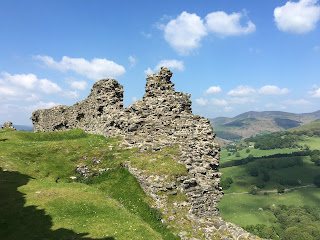skip to main |
skip to sidebar
 Dolwyddelan (pronounced doll-ooey-thellann) is a true Welsh castle, in that it was built by the Welsh, rather than by Edward I or some other Englishman for the purpose of oppressing the Welsh. It is reputed to have been built in the early 13th century by the greatest Welsh prince of them all, Llywelyn ap Iorwerth (known as Llywelyn the Great) who came the closest to uniting the Welsh (or the Cymry, as they like to be called) as was possible in the Middle Ages.
Dolwyddelan (pronounced doll-ooey-thellann) is a true Welsh castle, in that it was built by the Welsh, rather than by Edward I or some other Englishman for the purpose of oppressing the Welsh. It is reputed to have been built in the early 13th century by the greatest Welsh prince of them all, Llywelyn ap Iorwerth (known as Llywelyn the Great) who came the closest to uniting the Welsh (or the Cymry, as they like to be called) as was possible in the Middle Ages.
Llywelyn the Great was born at Tomen Castell, a fortress on a hill an arrowshot or two away from Dolwyddelan.
Although it was added onto twice, bringing the tower to the current height of 40 feet, Dolwyddelan is not large for a castle. Its modest size makes it seem more like a place people could actually live than a lot of castles.
What's most impressive about it are the views.
The setting.
And the magical sense of the past come to life.
Situated high above the Dee Valley in north Wales are the remains of a medieval stronghold known as Castell Dinas Bran. It was built in the late 1260's by Welsh prince Gruffydd Maelor II. But this era was a turbulent time, and the fortress survived less than two decades before it was destroyed by the forces of Edward I, as part of his brutal subjugation of Wales.
The curtain wall of the fort encompassed an area of approximately 300 by 130 feet. At the east end was a two-story keep connected to a gatehouse. On the west end was a D-shaped tower that afforded a lookout over the most accessible approach up the hillside. There were also a two-story hall, where the lord would have had hosted banquets.

 The hilltop was an important defensive site long before the medieval era. The earthworks below the ruins date from the iron age, indeed, "dinas" is an ancient term for hillfort.
The hilltop was an important defensive site long before the medieval era. The earthworks below the ruins date from the iron age, indeed, "dinas" is an ancient term for hillfort.
 And the other part of the name comes from King Bran, who is mentioned in the Mabinogion, a collection of tales dating to the Arthurian era. Bran means raven, giving the site a further mystical appeal.
And the other part of the name comes from King Bran, who is mentioned in the Mabinogion, a collection of tales dating to the Arthurian era. Bran means raven, giving the site a further mystical appeal.

The climb up the hill is steep, and even more challenging if, like me, you miss the marked pathway and end up bushwacking through the dense bracken.
Thank goodness for my fabulous boots.
But I would have happily struggled up a hill twice as steep to visit Castell Dinas Bran. The views are spectacular and the atmosphere magical.
I felt as if I had been transported back in time, and kept expecting to see a dark age army riding through the valley below or a lady garbed in a medieval gown walking through one of the stone archways.
And, as so often happens in Wales, I had the sense that this is a place where my spirit belongs. The genealogical research I've done so far hasn't turned up any Welsh roots, but they must be there somewhere.
 In the next on my journey back in time I am transported to the late Neolithic era as I visit the Holyhead Mountain hut circles. The scenery is spectacular: craggy moss-covered cliffs, meadows full of wildflowers, a heather-clad mountain, and on clear days, a glimpse of Ireland across the shimmering blue sea.
In the next on my journey back in time I am transported to the late Neolithic era as I visit the Holyhead Mountain hut circles. The scenery is spectacular: craggy moss-covered cliffs, meadows full of wildflowers, a heather-clad mountain, and on clear days, a glimpse of Ireland across the shimmering blue sea.
 Holyhead Mountain is situated on the edge of Britain, with only the Irish Sea and Ireland between this point and the vast expanse of the Atlantic. Neolithic people settled within view of this mountain over 2,500 years ago, building the their round huts on the plain above the sea. They likely chose the location because the sea provided a year-round food source.
The remains of nearly fifty dwellings dot the flower-strewn plain. They would have had conical roofs, and turf or thatch walls supported by poles. There's something very imoving about these ancient dwellings with doorways and hearths still visible.
Walking among the bluebells and foxglove, you can almost feel the presence of these ancient people who chose this place for their home so long ago.
Holyhead Mountain is situated on the edge of Britain, with only the Irish Sea and Ireland between this point and the vast expanse of the Atlantic. Neolithic people settled within view of this mountain over 2,500 years ago, building the their round huts on the plain above the sea. They likely chose the location because the sea provided a year-round food source.
The remains of nearly fifty dwellings dot the flower-strewn plain. They would have had conical roofs, and turf or thatch walls supported by poles. There's something very imoving about these ancient dwellings with doorways and hearths still visible.
Walking among the bluebells and foxglove, you can almost feel the presence of these ancient people who chose this place for their home so long ago.
 Dolwyddelan (pronounced doll-ooey-thellann) is a true Welsh castle, in that it was built by the Welsh, rather than by Edward I or some other Englishman for the purpose of oppressing the Welsh. It is reputed to have been built in the early 13th century by the greatest Welsh prince of them all, Llywelyn ap Iorwerth (known as Llywelyn the Great) who came the closest to uniting the Welsh (or the Cymry, as they like to be called) as was possible in the Middle Ages.
Dolwyddelan (pronounced doll-ooey-thellann) is a true Welsh castle, in that it was built by the Welsh, rather than by Edward I or some other Englishman for the purpose of oppressing the Welsh. It is reputed to have been built in the early 13th century by the greatest Welsh prince of them all, Llywelyn ap Iorwerth (known as Llywelyn the Great) who came the closest to uniting the Welsh (or the Cymry, as they like to be called) as was possible in the Middle Ages. 































